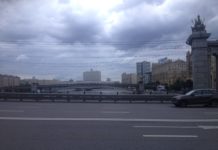Having been fortunate enough to have been personally invited by one of the photographers responsible for contributing towards this fascinating exhibition in the heart of Exeter at a private screening, I feel obliged to share this experience with supporters of the WRF and all other interested parties!
On Wednesday the 17th of January, Exeter’s Royal Albert Memorial Museum (RAMM) opened its doors after hours for a private opening of the exhibition ‘A Photographic Essay of Two Cities’. Attracting a great deal of attention, and the product of a great collaborative effort, the event hosted members of Exeter city council, the Lord Mayor, the Chair of the Exeter Yaroslavl Twinning Association (EYTA), its members, and many more. Photographers Marija Lees and Aleksei Lobanov, from Exeter (United Kingdom) and Yaroslavl (Russia) respectively, also attended to see the fruits of their hard work presented in all their glory.
Marija Lees, the Exeter-based photographer, is a Licentiate of the Royal Photographic Society and a member of the Exeter Camera Club with a keen interest in photo-journalism. For Marija, it was important to visit and photograph Yaroslavl at winter as she considers Russia’s harsh and unforgiving winters as formative on Russian society and the peoples’ way of life. We do indeed get a strong impression of the cold and its effect on Yaroslavl’s citizens as they go about their daily activities in Marija’s photos.
Aleksei Lobanov was born in the Yaroslavl region of Russia, part of the ‘Golden Ring’, and has lived and worked in Yaroslavl proper since 1997. Previously focused on nature photography, Aleksei now delves into, with great success, other genres of photography with some of the photos at the exhibition capturing Exeter’s residents buzzing around on their own business in its crowded centre. Aleksei has also participated and received great acclaim in many exhibitions and projects, many of which international.
The evening opened ceremoniously with speeches from the Museums Manager of RAMM, Exeter’s Lord Mayor, the two photographers Marija and Aleksei, and Chair of EYTA, Peter Barker. Needless to say, all were very excited to be there and stressed their gratitude to the people who enabled the facilitation of this wondrous cultural exchange to take place and be captured in such beauty by the two talents responsible for the photos.
All parties praised what supporters of the WRF already hold dear, the merits of cross-cultural exchange, dialogue, learning and mutual understanding. This exhibition captured, stylistically, the similarities and disparities of life in these two cities. The photos captured not just the striking architecture, from Exeter’s majestic cathedral to Yaroslavl’s glorious onion-domed churches and monasteries, but the faces of the people and inhabitants of both cities in their trials and tribulations, commutes, and celebrations alike. For me, the photos captured the diversity of common human experience between the two locations, yet simultaneously underlined the fact that human experience, from the mundane to the ethereal, is the same no matter the environments we find ourselves in.
Marija Lees has been kind enough to allow me to share some of her wondrous photos here, so you can have a glimpse of her interpretation of a wintery Yaroslavl:
As Marija noted with this picture, what she found fascinating was the scale of the domes against the backdrop of Yaroslavl’s covering of snow.
Below, Marija’s attention was caught by the monochromatic juxtaposition of the birch against the church.
What was interesting about both Marija’s and Aleksei’s photos was that they captured the two cities from the eyes of an outsider and thus documented these fleeting interpretations in photographic form. As an Exeter native, seeing Aleksei’s photos was especially interesting as, rather obvious upon reflection, Exeter looked a lot different, and had a great deal more to offer, through the eyes of a visitor from overseas. I have touched upon this, for it is interesting, and imperative, to note that the world reveals itself in different ways to different people. Experience is entirely subjective, and in this case, beauty and wonder bestow themselves to others in different ways. The twinning of Exeter and Yaroslavl is thus a great asset to both cities insofar as it facilitates such invaluable exchange between the two peoples who, of course, share a great deal more in common than many may initially suppose.
As well as being supported financially by Exeter City Council, the exhibition was organised primarily by the Exeter Yaroslavl Twinning Association (http://www.eyta.org.uk/). This organisation itself deserves mention for the great work it does in enabling continued cultural exchange to take place between the two twin cities, as well as providing the opportunity for this captivating project to have taken place. The cities, having been twinned for 28 years to date, both support and benefit from the mutual understanding, respect and friendship that stems from this channel of communication and exchange and is entrenched in the twinning Charter.
EYTA is a fantastic and welcoming society that opens its doors to anyone and everyone wishing to get involved, be it to learn a little more about life and culture in Yaroslavl and Russia, to start learning Russian, or to take part in the annual exchange where members can apply to go to Yaroslavl and host residents of Yaroslavl at their homes in Exeter – I have since joined and would recommend others to seek other twinning societies in their hometowns!

